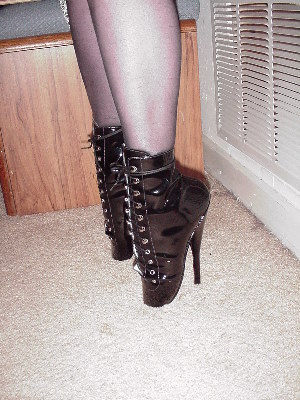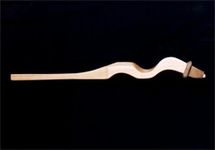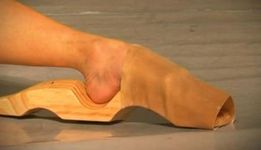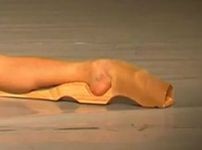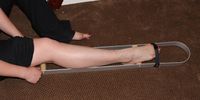Ballet boot
The ballet boot is a contemporary style of fetish footwear that merges (the look of) the pointe shoe with the ultimate high heel. The idea (along with the illusion) is to force the wearer's feet almost en pointe, like those of a ballerina, with the aid of long, slender heels. When upright, the feet are held nearly vertical by the heel, thus putting nearly all of the body's weight on the tips of the toes. Some styles are equipped with supports similar to the toe box and shank of pointe shoes, though, unlike those of the pointe shoe, the structural design, construction, and integrity provide only limited mobility.
The heel height is typically 7 inches (18 centimeters) or more, depending on the size of the shoe. This ultimate heel is of a maximum length so that the wearer's foot (ankle and toes) are fully pointed/extended in the shoe; any longer would prohibit the standing or would require a platform. The boots may rise to any height on the leg, but most designs stop at about the ankle or the knee. They have often laced up the front so that they may be made as tight as possible. The knee-high and thigh-high versions may also have zippers (zips) to allow them to be donned and doffed more easily. There are also dozens of "ballet shoe" designs, including sandals, mules, and Mary Janes, many of which have buckles.
Ballerinas began dancing en pointe in the Romantic era, with the first recorded performance in 1832 by Marie Taglioni, in La Sylphide. The soft satin slippers that were used took many decades to develop into the stiff-tipped pointe shoes that we have come to recognize in the 20th and 21st centuries, which allow for a greater range of virtuosic techniques. Aside from the ballet pointe shoe, another common ancestor to ballet boots and shoes is the Viennese fetish boot (circa 1900), which sported a dramatic 11-inch (28-centimeter) heel; the heel was actually longer than the sole of the shoe, thus making standing and/or walking impossible. Having grown in popularity since the 1980s, ballet boots and shoes are now available worldwide and through online shopping.
Ballet boots and shoes are not, however, intended for prolonged standing or walking. Instead, they act as a fetish object for sexual gratification, heightening the erotic appeal with the elements of bondage and submission, and a heel that can be used for penetration. They are thus sometimes used in BDSM play. For example, someone may be put in predicament bondage by being placed in suspension bondage arranged so that he or she must either hang by the arms or rest all of the body's weight on the toes. The boots, however, can cause enough discomfort by themselves: shortly after they are donned, the calves often begin to cramp and sting from overexertion if the wearer is not used to them.
Many fetishists of feet or footwear adore this type of boot. Beginners often find momentary walking and/or standing in them to be difficult and painful, which may also appeal to masochists. Arch-training devices are sometimes used to increase the wearer's instep in order to fit high heels such as these.
Ballet sneakers
Ballet Sneakers, also known as a skimmer, have elements of both a ballet flat and sneaker. The top line of a ballet sneaker is very open like a ballet flat. The upper is typically made of multiple layers of fabric. They have rubber soles like sneakers. These shoes aren't very supportive, which explains why the average wearer is between 13 and 30. Ballet Sneakers have only come into fashion recently.
References
Barringer, Janice, and Sarah Schlesinger. The Pointe Book: shoes, training & technique. Hightstown, NJ: Princeton Book Company, 2004.
Sanity check 10-22-2019 R/
A "little shopping around" on eBay and/or Amazon offers up several styles, sizes, and prices.
A Personal Note from Robin
One method of training ankles and feet to wear ballet boots for protracted periods of time is to use a wooden foot stretcher. They are used by ballet dancers to strengthen and stretch leg muscles and Achilles tendons.
I (Robin Roberts) made the stretcher from a piece of extruded aluminum and two short pieces of wooden dowel and less than a half an hour of time.
| Shoes | |
| Boots | |
| Types of heel | |
| Portal:Clothing articles |
|---|
|
Chat rooms • What links here • Copyright info • Contact information • Category:Root
